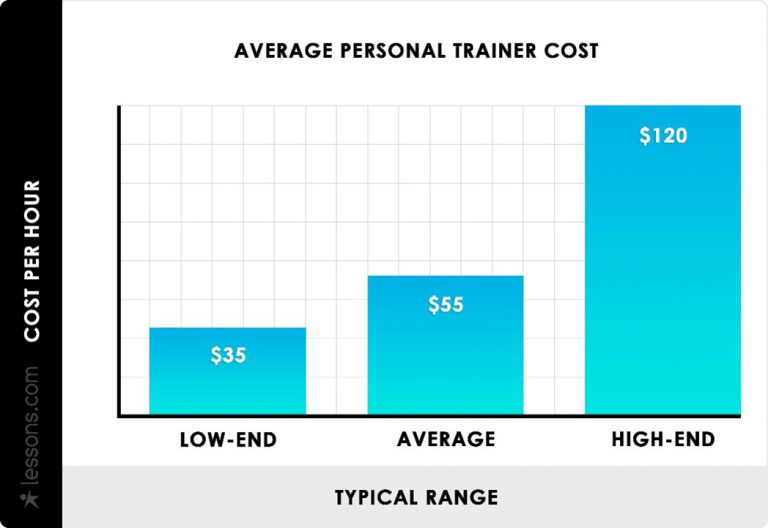Get ready to print your personal trainer business cards!
Congratulations on earning your personal trainer certification! Now is a great time to start your personal training business and take advantage of all the new opportunities for growth in the fitness industry. According to the U.S. Bureau of Labor Statistics, the job outlook for fitness trainers and instructors is expected to increase 15%1 between 2019 – 2029. That means more personal training jobs and more opportunities for you. Whether you want to be an online personal trainer or a fitness coach at the hottest gym in town, this guide will help you build a booming personal training business right now.
Starting a personal training business
Starting a personal training business can be an exciting time for fitness enthusiasts eager to impart their knowledge to others. Before you jump straight into the fun, there are some legal requirements you need to take care of to set up your personal training business properly. Requirements and regulations can vary based on where you are located and your specific job, so make sure to do the proper research. Some general items you can add to your to-do list include:
- Forming a legal entity
- Registering for taxes
- Opening a business bank account (Woligo offers great banking solutions for your personal training business)
- Setting up business accounting
Finding a niche
Once you set up your personal training business, it’s time to dig into finding a niche. Sure, you could be a fitness coach that trains anyone for anything, but being an ‘expert’ in a particular area helps you stand out from the competition. Niche’s to consider include:
- Online personal trainer
- Competitive bodybuilding
- Training for triathletes
- Pregnancy fitness coach
- Wedding fitness
- Bootcamp trainer
- Spin instructor
- Senior citizens
- Young athletes
- The physically impaired
- People who only want to lose weight
- Professionals who are too busy to work out
Selecting a niche offers a variety of benefits that can help you get personal training clients. For example, a niche will help you reach your target audience by personalizing marketing efforts toward them. For example, the marketing used to target brides before their big day would vary significantly from targeting competitive bodybuilders.
A niche can also make clients feel more confident to hire you because they are getting an expert in their specific interests. Of course, there are many other ways you can specialize with personal training jobs. It’s just a matter of figuring out what kind of fitness coach you want to be.
Personal training jobs
There are many different types of personal training jobs, and deciding on one can intertwine with selecting a niche. If you want to be your own boss, you might lean toward freelancing as a fitness coach. If you don’t want anything to do with business operations and just want to work out and train, then you might prefer getting a job at an established gym that does all of the recruiting, marketing, and paperwork for you. Below we explore different types of personal training jobs and what they entail.
Working at a facility
The great thing about working at a facility is that you have the option of looking for full-time or contract personal training jobs. As a contract fitness coach, you might be able to have a flexible schedule or even work at more than one facility if you crave diversity in your career. And if you want to find a full-time personal training job, then you can work for an employer in a health or fitness environment while also enjoying the comfort of benefits and paid time off.
And while a gym or health club might be the first place that comes to mind when you think of working at a facility, the possibilities are endless. Community centers, senior living facilities, spas, resorts, physical rehabilitation facilities, and spin studios are just a few other types of facilities that can have opportunities for personal training jobs.
An enormous benefit of working at a facility as a fitness coach is that chances are the facility will provide you with space, equipment, and accessories needed to train your clients. This type of personal training job would require little to no upfront costs to begin your career as a personal fitness trainer. On the other side, a disadvantage of working at a facility is that you might be required to sign a non-compete agreement. A non-compete agreement is a legal agreement between an employer and an employee where the employee agrees not to use information learned during employment to enter into competition in subsequent business efforts.2
In the world of personal training, this could translate to you never being able to train clients you met at or through the facility outside of the facility or as a freelance personal trainer. If you did breach the non-compete agreement, the facility could file a lawsuit against you.
Freelancing as a fitness coach
Freelancing for your personal training job gives you the flexibility to choose who you train, where you train, and how you train them. You could decide to market yourself as a personal trainer that comes to a client’s home or offer workout classes in a park.
On the other hand, freelancing as a fitness coach also means extra responsibilities and costs compared to working at a facility. You would be responsible for client acquisition, marketing, business equipment, and other operational expenses for your personal training business. Workout equipment alone can hinder you if you have to constantly transport it or make sure you have enough sets to teach a group fitness class. Where you train a client could also be a biggie – can you afford to rent space in a fitness studio? If you want to train clients at a park, are you required to get a permit?
Freelancing is just one of the types of personal training jobs you could choose to pursue. No matter which personal training job you choose, make sure you do the proper research.
Online personal trainer
Demand for online personal trainers has flourished as the popularity of social media and technology has risen. YouTube, Tik Tok, Zoom, Facebook Live, Instagram Reels, and other platforms allow clients to access online personal trainers from anywhere at any time. As an online personal trainer, you could create and sell a PDF fitness program complete with workout routines and recipes; you could record training circuits that users can pay to subscribe to or offer live, personal training through apps like FaceTime or Zoom. Technology has now made it possible for online personal trainers to provide fitness programs to clients anywhere in the world as long as they have a high-speed internet connection and space to exercise in.
A unique benefit to becoming an online personal trainer is developing a passive form of income. If you sell a non-personalized workout routine online or produce training videos, you can literally make money while you sleep. Static personal training programs you sell on a website or social media platform can be accessed and purchased by potential clients 24 hours a day/ 7 days a week.
If you are just starting as a personal trainer, it would be good experience to start by training clients in-person or at least experimenting with a hybrid model before exclusively becoming an online personal trainer. We all know how helpful technology can be, but there is also a consensus that virtual communication lacks a personal touch. If you don’t know what it’s like to train someone in person, you may have problems connecting with someone through a screen.
A hybrid personal training model could blend traditional personal training (in-person) with online personal training. For example, you could take an in-person client and create a PDF workout plan to follow when you don’t meet to train in person. In between training sessions, you can check in with your client via email or phone and sort through any problems when you are back together in person.
How to get personal training clients
If you’ve ever wondered how to get personal training clients, you’ve come to the right place. Whether you are learning how to get personal training clients for the very first time or are a seasoned professional looking to elevate your business, marketing should be a top priority. By choosing a few fitness coach marketing ideas and working on them a little bit every day, you will quickly be on the right track toward landing clients for your personal training business.
Write for industry blogs
A great way to showcase your expertise in the health and fitness space and get personal training clients is to get published by a highly regarded media outlet. Fitness newbies and enthusiasts look to blogs in the health and fitness space, and getting published there can quickly introduce yourself to a plethora of potential customers. It’s also a great thing to highlight on your marketing materials and social media accounts to build a solid repertoire and poise yourself as an expert in the field.
Start by making a list of reputable publications in the health and fitness space, research their writer guidelines and find contact information for the person in charge of content. Then, come up with some killer content and pitch them your idea.
As an example, EatingWell prefers pitches via email and asks that you send pitches to [email protected]. They also ask that you include “EatingWell Magazine Pitch” and the appropriate department in the subject line.
Start an email list
The average person checks their email about 15 times per day.3
That’s 15 times a day you have the opportunity to send a reminder and say, “Hey, fitness coach over here! Here is a health tip to remind you how good I am at my job for when you are ready to hire a personal trainer.”
You can start building an email list by offering a freebie online to people who sign up for your email list. The freebie doesn’t have to be anything complicated; it could be an eBook on foods to stay away from while trying to lose weight.
Partner with local health businesses
Finding a local business that offers healthy living services or products is a great way to tap into an already established consumer base since, chances are, your target audience will overlap. For example, you can check out local spin and yoga studios, coffee shops, or nutritional supplement stores. You could offer their employees a discount for your services, ask for them to display your signage, or pitch a mutually beneficial relationship where you recommend each other’s products or services. Relationship building is a great way to find clients and requires no upfront costs – other than your time.
Social media for your personal training business
Build a following on social media, and you’ll increase your chances of finding clients for your personal training business. It’s an easy (and free) way to demonstrate your experience and expertise firsthand to potential clients who need your services. Some social media content for your personal training business could be:
- Videos on how to correctly perform exercises
- Meal prep tutorials on healthy eating
- Workouts you can do at home
Remember, you want to use your social media to answer questions and provide value. If you post the right type of content, it will automatically sell you and your personal training business. Check out this Beginner’s Guide to Small Business Social Media for more ways to get qualified leads and build brand loyalty.
Invest in insurance
You wouldn’t drive a car without collision insurance, so why wouldn’t you get insurance for your personal training business? Sure, you don’t expect anything bad to happen. But you never know. General liability insurance and professional liability insurance are a must when it comes to your personal training business.
General liability insurance can help cover lawsuits that may emerge from your personal training business. This includes third-party bodily injury, third-party property damage, and reputational harm. For example, if someone slips in your fitness studio, you could be at risk of a claim. General liability insurance may cover the cost of the lawsuit and medical bills that result from an accident on your premises or because of your operations as an independent contractor.
Professional liability insurance protects your personal training business if a personal training client believes that your advice led to injury, damages, or losses. They might file a claim against you — whether or not you are actually at fault. You put a lot of work into launching and growing your personal training business, and that’s why it’s essential to protect it. If a client is injured during a personal training session and you find yourself on the wrong side of a lawsuit, professional liability insurance could be a lifesaver. It can help pay for court costs, attorney fees, settlements, and judgments.
And, if you open up your own fitness studio or invest in personal training equipment for your business, you can’t forget commercial property insurance. Commercial property insurance is protection for your income if your physical workspace is damaged. We know that your brain and your muscles are your biggest assets for your personal training business, but your studio space, your equipment, your computer, and all of the other furnishings in your work area are pretty important, too. If your studio space or the equipment inside is damaged, commercial property insurance helps cover the income you lose while making repairs or purchasing replacement parts. The funds help your business continue to operate without disruption after a fire, burst pipes, storm, vandalism, or other covered damage.
How much do personal trainers make?
On average, personal trainers charge $25 to $50 per 30-minute session, $40 to $75 per hour session, and $60 to $100 per 90-minute session.4
The amount you charge for a personal training session is determined by several different factors, such as the session’s location, length of the session, trainer expertise, trainer education, and the operational costs to run your personal training business.
When you think about your rate, don’t forget to factor in things like how much you pay in rent for your studio space, how much you pay for insurance to protect your business, taxes, and other costs associated with running your personal training business. You could have one hundred clients to train a week, but if you cannot cover your business expenses, it isn’t a sustainable model.
Graphic by Lessons.com
How to become a successful personal trainer
The demand for personal trainers is growing steadily, and there are no signs of it slowing down any time soon. Building a personal training business provides you with enormous flexibility and the opportunity to be your own boss – so get started today!
Sources:
- Fitness Trainers and Instructors : Occupational Outlook Handbook: : U.S. Bureau of Labor Statistics (bls.gov)
- Non-Compete Agreement Definition (investopedia.com)
- I quit checking my email after hours for one week and this is what happened (theladders.com)
- 2021 Personal Trainer Cost | Average Rates Per Hour & Month (lessons.com)



